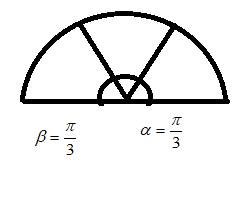
The electric field intensity at the centre of a uniformly charged hemispherical shell is $E_{0}$. Now two portions of the hemisphere are cut from either side, and the remaining portion is shown in figure. If $\alpha=\beta=\dfrac{\pi}{3}$, then the electric field intensity at the centre due to the remaining portion is :
\[\begin{align}
& A.\dfrac{{{E}_{0}}}{3} \\
& B.\dfrac{{{E}_{0}}}{6} \\
& C.\dfrac{{{E}_{0}}}{2} \\
& D.\text{information insufficient} \\
\end{align}\]
Answer
559.2k+ views
Hint: Electric field is the electric force due to a unit positive charge which is at rest would exert on its surrounding. We also know that the electric potential due to a charge, is defined as the amount of energy needed to move a unit positive charge to infinity. Using the relation between the two we can solve this sum.
Formula used: $E=\dfrac{V}{r}$ and $E=-\nabla V$
Complete step by step answer:
We know that the electric force due to a pair of charges is given by Coulomb's law. An electric field can be produced by a time-varying electric field or an electrical charge. These can be either attracting or repelling in nature.
An electric field E is defined as the electric force F per unit positive charge q, which is infinitesimally small and at rest, and is given as $E=\dfrac{F}{q}$. Then $E=\dfrac{kq}{r^{2}}$, where $k=\dfrac{1}{4\pi\epsilon_{0}}$ which is a constant and $r$ is the distance between the unit charges. Since the electric field is a vector quantity, it acts along the direction of the distance $r$, then we can denote it as $\vec E=\dfrac{kq\vec r}{r^{3}}$.
Given that the electric field of the hemispherical shell as shown below is $E_{0}$. If it is cut as below, let the new electric field be $E_{1}$

Since the electric field is a vector quantity, we can say that the vertical component of the side parts add as $2E_{1}sin(30)$ with the middle electric field $E_{1}$.
Then we can say $E_{0}=\dfrac{2E_{1}}{2}+E_{1}=2E_{1}$
$\implies E_{1}=\dfrac{E_{0}}{2}$
So, the correct answer is “Option C”.
Note: Electric field is the electric force due to a unit positive charge which is at rest would exert on its surrounding. We also know that the electric potential due to a charge is defined as the amount of energy needed to move a unit positive charge to infinity. Using the relation between the two we can solve this sum.
Formula used: $E=\dfrac{V}{r}$ and $E=-\nabla V$
Complete step by step answer:
We know that the electric force due to a pair of charges is given by Coulomb's law. An electric field can be produced by a time-varying electric field or an electrical charge. These can be either attracting or repelling in nature.
An electric field E is defined as the electric force F per unit positive charge q, which is infinitesimally small and at rest, and is given as $E=\dfrac{F}{q}$. Then $E=\dfrac{kq}{r^{2}}$, where $k=\dfrac{1}{4\pi\epsilon_{0}}$ which is a constant and $r$ is the distance between the unit charges. Since the electric field is a vector quantity, it acts along the direction of the distance $r$, then we can denote it as $\vec E=\dfrac{kq\vec r}{r^{3}}$.
Given that the electric field of the hemispherical shell as shown below is $E_{0}$. If it is cut as below, let the new electric field be $E_{1}$

Since the electric field is a vector quantity, we can say that the vertical component of the side parts add as $2E_{1}sin(30)$ with the middle electric field $E_{1}$.
Then we can say $E_{0}=\dfrac{2E_{1}}{2}+E_{1}=2E_{1}$
$\implies E_{1}=\dfrac{E_{0}}{2}$
So, the correct answer is “Option C”.
Note: Electric field is the electric force due to a unit positive charge which is at rest would exert on its surrounding. We also know that the electric potential due to a charge is defined as the amount of energy needed to move a unit positive charge to infinity. Using the relation between the two we can solve this sum.
Recently Updated Pages
Master Class 12 English: Engaging Questions & Answers for Success

Master Class 12 Business Studies: Engaging Questions & Answers for Success

Master Class 12 Economics: Engaging Questions & Answers for Success

Master Class 12 Social Science: Engaging Questions & Answers for Success

Master Class 12 Maths: Engaging Questions & Answers for Success

Master Class 12 Chemistry: Engaging Questions & Answers for Success

Trending doubts
What are the major means of transport Explain each class 12 social science CBSE

Which are the Top 10 Largest Countries of the World?

Draw a labelled sketch of the human eye class 12 physics CBSE

Explain sex determination in humans with line diag class 12 biology CBSE

The pH of the pancreatic juice is A 64 B 86 C 120 D class 12 biology CBSE

Explain sex determination in humans with the help of class 12 biology CBSE




